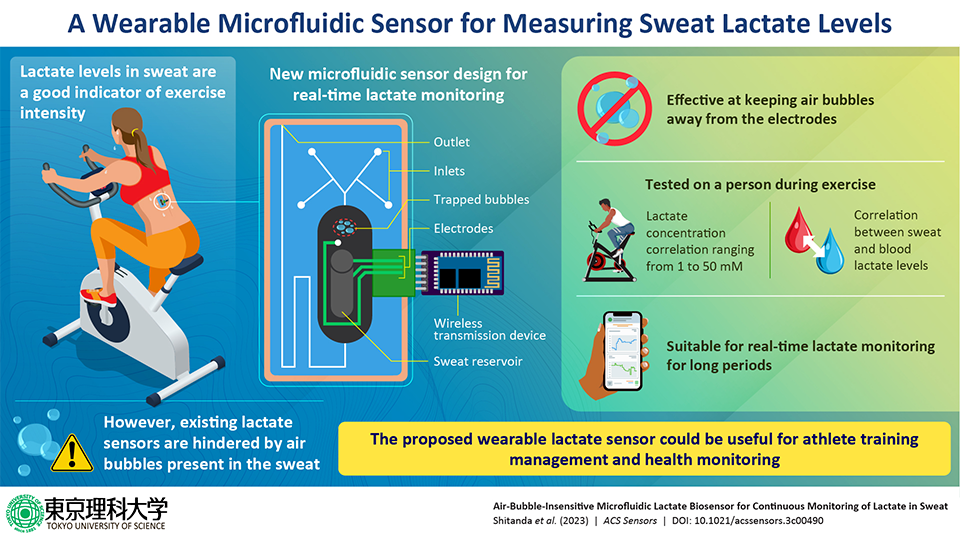
Image Credit: Tokyo University of Science
In a recent study, scientists from Japan created a wearable sensor with a bubble-trapping zone in its microfluidic system to detect sweat lactate during exercise. The suggested technology can make it easier to manage an athlete’s training and monitor their health.
Human perspiration is a valuable source of health data, including details about hydration status, electrolyte balance, and general physiological health. Lactate level in perspiration, for instance, is a helpful biomarker of exercise intensity. Its measurement can aid in determining the blood’s lactic acid content and, thus, forecast muscular weariness.
Currently, wearable sensors allow for the continuous monitoring of indicators like sweat lactate. Researchers have created systems that deliver minute quantities of sweat to small chemical sensors, which can wirelessly send readings in real time, using the most recent advancements in microfluidics technology.
However, one issue with such devices is that their microfluidic channels have a propensity to trap air bubbles found in perspiration. The electrodes on the sensor are covered by these bubbles, which disrupts readings and prevents the target biomarker from being continuously monitored.
To solve this problem, a research team from the Tokyo University of Science (TUS) in Japan, led by Associate Professor Isao Shitanda, developed a unique microfluidic sweat lactate sensor whose measurements are unaffected by air bubbles.
Dr. Masahiro Motosuke, Dr. Tatsunori Suzuki, Dr. Shinya Yanagita, and Dr. Takahiro Mukaimoto from TUS contributed to the study, which was published in ACS Sensors on June 23rd, 2023, and made accessible online on May 22nd, 2023.
The suggested wearable device has a simple layered construction, with a typical lactate oxidase sensor taped to a silicone polymer microfluidic system. Sweat enters the microfluidic channels through four inlets when the person wearing the device starts to perspire, and it flows into a reservoir close to where the electrodes are placed.
A tiny wireless transmitter transmits the measured lactate levels when new sweat enters the system, and old sweat escapes through an outlet.
The utilization of a larger-than-usual sweat reservoir was the suggested design’s main novelty.
By increasing the length of the reservoir in the microfluidic channel, a space of approximately four microliters was created for trapping any air bubbles that infiltrate the device, thereby preventing them from contacting the electrodes of the sensor.
Isao Shitanda, Associate Professor, Tokyo University of Science
Through a series of lab tests, the researchers evaluated the sensor. By pumping bubbles into the apparatus and analyzing the amounts of lactate in fake perspiration, they were able to confirm that the bubble-trapping zone functioned as expected.
The findings were also unaffected by sweat flow rate, and the sensor’s reaction remained constant for around two hours. Finally, the gadget was tested on a male volunteer who exercised for over an hour on a stationary bike.
The sensor revealed a link between sweat and blood lactate levels as well as a lactate concentration correlation spanning from 1 to 50 mM.
The study’s findings suggest that wearable microfluidic sensors could prove useful for tracking sweat biomarkers while exercising.
Dr. Shitanda further added, “Since the microfluidic system of the proposed lactate sensor is fabricated from a soft, flexible, and non-irritating material, it could be used to continuously monitor lactate levels in sweat, especially in sports and medicine. Wearable lactate sensors may become useful condition management tools in sports such as soccer and basketball, allowing team managers to know when it's best to replace a player.”
Only time will tell how healthcare monitoring and training management will change as wearable sensors improve in capability and dependability.
JST-ASTEP grant number JPMJTR21UF and JSPS KAKENHI grant number 21H03344 contributed to the funding of this study.
Journal Reference
Shitanda, I., et al. (2023) Air-Bubble-Insensitive Microfluidic Lactate Biosensor for Continuous Monitoring of Lactate in Sweat. ACS Sensors. doi:10.1021/acssensors.3c00490.